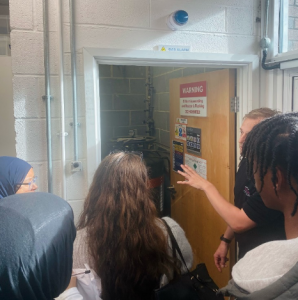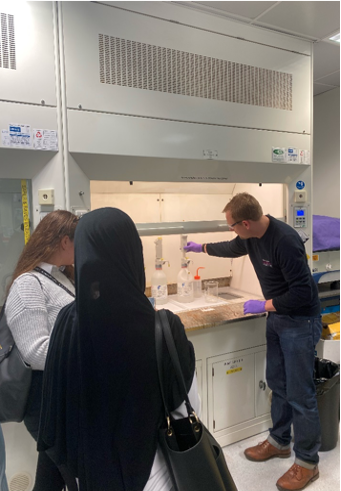By PGCE Science alumnus Ruqaya Mayouf (2023-24), now teaching in a local 11-18 high school
Part of the BTEC level 3 Applied science coursework requires students in describibng the potential hazards within a scientific working environment as well as explain health and safety measures in place, to ensure the organisation complies with legislation. A visit to one of the university laboratories in the School of Environment, Education and Development (SEED) provided the ideal context for this.
Students were guided throughout different scientific working environments in the Arthur Lewis building by the lab manager Tom, where they had to walk around and identify any potential risk. The students were questioned on what strategies the university implements to minimise the hazards associated with the identified risks.
The students were exposed to a working environment that they have never been to before and were shown advanced instruments such as Xray machines, HPLC machine, gas chromatography machine, mass spectrometry machine, a centrifuge, and a pulveriser. Besides providing the students with opportunity to strengthen their knowledge on health and safety to support their coursework, this trip also allowed students to understand the skills and entry requirements for work as a lab manager and in health and safety.



Students were shown the different chromatography machines and understood why different machinery require different risk management, as well as how risk management is more than just PPE or physical precautions and that appropriate training is top priority in the hierarchy of control. Knowing that acids are corrosive, students were shown the benefit of using a dispenser to minimise contact of any corrosive liquids with the skin. Students were shown how to use the shower in the lab and how it is put in place in case of any accidental chemical spills

Finally, students had a look at a securely enclosed cylinder containing argon gas which is an asphyxiant. They had to look around to notice any precaution in place that are used to minimise risk. Many identified the alarm bell above the door, which indicates any potential gas leaks, as well as the presence of PPE inside the room the ensure people are handling and carrying the gas safely.

Many thanks to Tom for his willingness to host this extremely valuable visit, and for the highly communicative approach to explanations and questions which made it so memorable. We hope to be back!
Ruqaya Mayouf and Year 12 Applied Science
It was a real pleasure to have such an enthusiastic group!
Tom Bishop, Senior technical manager, SEED

